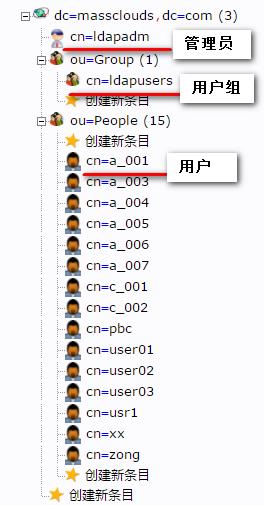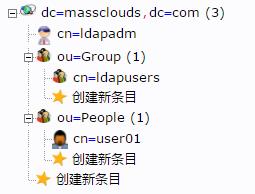LDAP学习
Posted zh1164
tags:
篇首语:本文由小常识网(cha138.com)小编为大家整理,主要介绍了LDAP学习相关的知识,希望对你有一定的参考价值。
LDAP概述
目录系统是关于某些类别的对象(例如人)的信息列表。目录可以用于查找特定对象的信息,也可以反方向查找满足特定需求的对象。 企业中的员工通讯录就是一个目录系统。目录访问协议(directory access protocol)就是用来访问目录中数据的标准化方式。最广泛使用的是 轻量级目录访问协议(lightweight directory access protocol,LDAP),openldap是LDAP的一个开源实现。
LDAP数据模型
在LDAP目录中存储的是类似于面向对象语言中 对象 的条目(entry)。每个条目必须有一个能标示自己的 可区别名称(distinguished name, DN),DN又由一组 相对可区别名称(relative DN, RDN)组成。
例如(下面的例子都存在于我们后面将要搭建的openldap环境中):
cn=user01,ou=People,dc=massclouds,dc=com
这个DN唯一标示的条目代表了目录中的一个人。 其中各个RDN的含义是:
cn: common name(s) for which the entity is known by
ou: organizational unit this object belongs to
dc: domain component
就像面向对象语言中的对象一样,条目 也有所属的类,也拥有自己的属性。条目可以属于多个类,这些类也拥有继承关系。 而条目中的属性就是定义在这些类中的。关于objectclass 、属性的规则是定义在schema中的。
下面是定义一个条目的LDIF(LDAP Data Interchange Format, LDAP数据交换格式):
dn: cn=user01,ou=People,dc=massclouds,dc=com
cn: user01
gidnumber: 500
homedirectory: /home/user01
loginshell: /bin/bash
objectclass: inetOrgPerson
objectclass: posixAccount
objectclass: top
sn: user01
title:
uid: user01
uidnumber: 836031732
userpassword: {SSHA}25vgYD/sRglAUSKLKfIU7hya9Kp/cFUS
上面的例子中,表示user01的条目属于三个objectclass: inetOrgPerson 、posixAccount和top。 objectclass分为 结构型、辅助型和抽象型,每个条目必须要属于一个结构型的objectclass。 在objectclass中定义了必须的属性和可选的属性,条目如果属于某个objectclass,那么就必须要有这个objectclass所有的必须属性。

条目按照它们的DN组织成一颗 目录信息数(Directory Intermation Tree, DIT),树的叶子节点通常表示特定的对象,而内部节点表示组织、部门等上层信息。 一个节点必然会包含它父节点的所有RDN。

上面所展示的就是一个DIT,叶子节点分别表示 管理员节点(cn=ldapadm),具体的用户组(cn=ldapusers)和具体的用户(cn=a_001),而其他内部节点则是用来分类管理这些叶子节点的上层节点。从这颗DIT中我们可以得到user01完整的dn为:cn=user01,ou=People,dc=massclouds,dc=com, 而People这个内部节点的完整dn为: ou=People,dc=massclouds,dc=com, 子节点完全拥有父节点的所有rdn。
搭建OpenLDAP环境
在网上可以找到很多搭建openldap的文章,但很多都是针对比较旧的版本的。 下面的步骤基本来自 Step by Step OpenLDAPServer Configuration on CentOS 7 / RHEL 7 这篇文章,这里记录下来留作自己参考,你也可以直接阅读原文就好了。
环境:
openladp-server: 192.168.107.177 (centos 7)
openldap-client : 192.168.107.178 (centos 7)
搭建服务端:
安装软件:
yum -y install OpenLDAPcompat-OpenLDAPopenldap-clients openldap-servers openldap-servers-sql openldap-devel
启动服务和开机启动(slapd是openldap-servers的服务名):
systemctl start slapd.service systemctl enable slapd.service
389是openldap的默认端口,验证服务是否启动:
netstat -altpn | grep 389 tcp 0 0 0.0.0.0:389 0.0.0.0:* LISTEN 4358/slapd tcp6 0 0 :::389 :::* LISTEN 4358/slapd
OpenLDAP有一个创建密码的工具 slappasswd,在下面介绍jldap的内容中会有一个 算法逻辑相同的 java实现。
-h 指定加密算法 {MD5} {ssha}等 -s 指定希望加密的明文密码
slappasswd -h {ssha} -s 123456
{SSHA}aMRnRqs2Kicc0ZtSsaU2B3Duhc2CFxO6
我们需要使用slappasswd生成一个管理员密码,例如上面由123456生成的那个,并把它保存起来,后面会用到。
配置OpenLDAPserver:
OpenLDAPservers 的配置文件在/etc/openldap/slapd.d/下面。我们需要修改“olcSuffix”和“oldRootDN”。
olcSuffix:ldap数据库前缀,它是LDAP server提供信息的域名,简单来讲就是你当前机器的域名,我的环境为massclouds.com。
olcRootDN: LDAP上超级管理员的DN
olcRootPW: RootDN的密码
我们其实想要修改的内容就存在于/etc/openldap/slapd.d/cn=config/olcDatabase={2}hdb.ldif 中,但是直接修改是OpenLDAP不建议的,所以我们通过编写一个LDIF文件来修改。

编辑db.ldif 如下:
dn: olcDatabase={2}hdb,cn=config
changetype: modify
replace: olcSuffix
olcSuffix: dc=massclouds,dc=com
dn: olcDatabase={2}hdb,cn=config
changetype: modify
replace: olcRootDN
olcRootDN: cn=ldapadm,dc=massclouds,dc=com
dn: olcDatabase={2}hdb,cn=config
changetype: modify
replace: olcRootPW
#这里就是刚才保存下来的那个加密后的密码
olcRootPW: {SSHA}o9CdHYvIqTp2o5RvA4Ci+wBUTwMHfN9J
注意replace: olcRootPW中冒号后面有一个空格,并且最后面也不要有任何空格或制表符。执行以下命令:
ldapmodify -Y EXTERNAL -H ldapi:/// -f db.ldif
执行完成后,你会发现/etc/openldap/slapd.d/cn=config/olcDatabase={2}hdb.ldif的内容已经发生了变化。
修改/etc/openldap/slapd.d/cn=config/olcDatabase={1}monitor.ldif (不要手动编辑)文件来只允许root(ldapadm)可以监控访问。编辑monitor.ldif 如下:
dn: olcDatabase={1}monitor,cn=config
changetype: modify
replace: olcAccess
olcAccess: {0}to * by dn.base="gidNumber=0+uidNumber=0,cn=peercred,cn=external, cn=auth" read by dn.base="cn=ldapadm,dc=massclouds,dc=com" read by * none
执行:
ldapmodify -Y EXTERNAL -H ldapi:/// -f monitor.ldif
创建LDAP证书
我们为LDAP服务器创建一个自签发的证书,下面的命令将在/etc/openldap/certs/目录中生成证书和私钥。
[root@localhost ~]# openssl req -new -x509 -nodes -out /etc/openldap/certs/masscloudsldapcert.pem -keyout /etc/openldap/certs/masscloudsldapkey.pem -days 365 Generating a 2048 bit RSA private key ........................................................+++ ....................................+++ writing new private key to \'/etc/openldap/certs/masscloudsldapkey.pem\' ----- You are about to be asked to enter information that will be incorporated into your certificate request. What you are about to enter is what is called a Distinguished Name or a DN. There are quite a few fields but you can leave some blank For some fields there will be a default value, If you enter \'.\', the field will be left blank. ----- Country Name (2 letter code) [XX]:CN State or Province Name (full name) []:Shandong Locality Name (eg, city) [Default City]:jinan Organization Name (eg, company) [Default Company Ltd]:Massclouds Technology Co., Ltd Organizational Unit Name (eg, section) []: Common Name (eg, your name or your server\'s hostname) []: Email Address []:
修改生成的证书和私钥的权限
chown -R ldap:ldap /etc/openldap/certs/*.pem
有了证书后,我们就可以配置OpenLDAP使用我们的证书安全通信了。编辑certs.ldif, 如下:
dn: cn=config changetype: modify replace: olcTLSCertificateFile olcTLSCertificateFile: /etc/openldap/certs/masscloudsldapcert.pem dn: cn=config changetype: modify replace: olcTLSCertificateKeyFile olcTLSCertificateKeyFile: /etc/openldap/certs/masscloudsldapkey.pem
执行:
ldapmodify -Y EXTERNAL -H ldapi:/// -f certs.ldif
配置这些之后,我们可以验证配置是否正确:
[root@localhost ~]# slaptest -u config file testing succeeded
建立LDAP数据库:
复制下面的这个数据库配置文件到/var/lib/ldap中,并更改文件权限。
cp /usr/share/openldap-servers/DB_CONFIG.example /var/lib/ldap/DB_CONFIG chown ldap:ldap /var/lib/ldap/*
添加cosine和nis LDAP schema (这些schema中定义了基本的objectclass,attribute)
ldapadd -Y EXTERNAL -H ldapi:/// -f /etc/openldap/schema/cosine.ldif ldapadd -Y EXTERNAL -H ldapi:/// -f /etc/openldap/schema/nis.ldif ldapadd -Y EXTERNAL -H ldapi:/// -f /etc/openldap/schema/inetorgperson.ldif
创建base.ldif,如下:
#根节点 dn: dc=massclouds,dc=com dc: massclouds objectClass: top objectClass: domain #管理员节点 dn: cn=ldapadm ,dc=massclouds,dc=com objectClass: organizationalRole cn: ldapadm description: LDAP Manager #管理所有人员的上层节点,它的子节点就是一个个表示具体人的叶子节点 dn: ou=People,dc=massclouds,dc=com objectClass: organizationalUnit ou: People #管理所有组的上层节点,它的子节点就是一个个表示具体组的叶子节点 dn: ou=Group,dc=massclouds,dc=com objectClass: organizationalUnit ou: Group
我们看一下上面这个文件,这里面定义的四个节点就构成了目录信息数(DIT)的大体结构,下面我们使用root(ldapadm)来将这些节点加入到ldap中。
[root@localhost ~]# ldapadd -x -W -D "cn=ldapadm,dc=massclouds,dc=com" -f base.ldif Enter LDAP Password: adding new entry "dc=massclouds,dc=com" adding new entry "cn=ldapadm ,dc=massclouds,dc=com" adding new entry "ou=People,dc=massclouds,dc=com" adding new entry "ou=Group,dc=massclouds,dc=com"
上面提示输入的就是在最开始我们为root(ldapadm)设置的那个密码。我们看到输出信息中已经提示为我们的目录信息数加入了四个节点。
下面我们来创建表示具体组和人的叶子节点,创建group.ldif(我们后面会讲到openldap的web控制台phpldapadmin,在其中我们可以更方便的执行节点操作)
dn: cn=ldapusers,ou=Group,dc=massclouds,dc=com cn: ldapusers gidnumber: 500 objectclass: posixGroup objectclass: top
执行:
ldapadd -x -W -D "cn=ldapadm,dc=massclouds,dc=com" -f group.ldif
创建 user01.ldif,如下:
dn: cn=user01,ou=People,dc=massclouds,dc=com
cn: user01
gidnumber: 500
homedirectory: /home/user01
loginshell: /bin/bash
objectclass: inetOrgPerson
objectclass: posixAccount
objectclass: top
sn: user01
uid: user01
uidnumber: 836031732
userpassword: {SSHA}wslbkdgQZUAnv+MvYgR3U1DGxSR8hwSL
执行:
ldapadd -x -W -D "cn=ldapadm,dc=massclouds,dc=com" -f user01.ldif
到此为止,我们就一共创建了六个节点,我们到phpldapadmin上面看一下DIT是什么样的:

另外还有 ldapsearch ldapdelete 等命令拥有查找、删除 等操作,就不介绍了。
配置ldap日志
配置Rsyslog来记录LDAP事件到日志文件 /var/log/ldap.log中。修改/etc/rsyslog.conf在后面加上一句:
local4.* /var/log/ldap.log
然后重启rsyslog服务,并重启slapd让ldap有事件发生,就会看到生成ldap.log文件了。
systemctl restart rsyslog systemctl restart slapd
最后不要忘记放开防火墙:
firewall-cmd --permanent --add-service=ldap firewall-cmd --reload
到此为止我们就已经搭建完成OpenLDAP的服务端了,下面我们来搭建OpenLDAP的客户端,这里需要说明一下,我们这里将使用OpenLDAP来集中管理客户端的账号,也就是说存在于server上的用户(例如上面创建的那个user01)可以直接在 client上登录。
安装软件
登录到客户端环境中,执行:
yum install -y openldap-clients nss-pam-ldapd
执行下面的命令来将客户端机器加入到LDAP server中来认证。 把下面的“192.168.107.177” 替换为你自己的LDAP server的ip或者hostname。
authconfig --enableldap --enableldapauth --ldapserver=192.168.107.177 --ldapbasedn="dc=massclouds,dc=com" --enablemkhomedir --update
重启客户端服务:
systemctl restart nslcd
到此我们就在客户端机器上配置完了,也就是说现在我们就可以在LDAP server上集中管理这台客户端机器上的账号了。
验证:
[root@localhost ~]# getent passwd user01 user01:*:836031732:500:user01:/home/user01:/bin/bash
在这台客户端中,的确是不存在user01这个用户的。
当我们使用user01 ssh登录客户端机器时可能会出现无法创建家目录的情况,关闭selinux就可以。
搭建LDAP web 控制台 phpLDAPadmin
phpLDAPadmin是使用php实现的一个管理OpenLDAP的web程序,我们将它部署在Apache Web Server(httpd)上,关于如何配置httpd就不再赘述了。
安装php环境:
yum -y install php php-mbstring php-pear php-ldap
下载phpldapadmin的安装文件,解压缩到/var/www/html目录中
wget https://nchc.dl.sourceforge.net/project/phpldapadmin/phpldapadmin-php5/1.2.3/phpldapadmin-1.2.3.zip unzip phpldapadmin-1.2.3.zip mv phpldapadmin-1.2.3 phpldapadmin
得到phpLDAPadmin的部署文件后,我们还要去配置需要访问的LDAP 服务器信息。
把/var/www/html/phpldapadmin/config/config.php.example 文件重命名为 /var/www/html/phpldapadmin/config/config.php, 然后在300行左右,把注释去掉,并修改如下:
293 $servers->setValue(\'server\',\'host\',\'192.168.107.177\'); 294 295 /* The port your LDAP server listens on (no quotes). 389 is standard. */ 296 $servers->setValue(\'server\',\'port\',389); 297 298 /* Array of base DNs of your LDAP server. Leave this blank to have phpLDAPadmin 299 auto-detect it for you. */ 300 $servers->setValue(\'server\',\'base\',array(\'dc=massclouds,dc=com\'));
之后重启httpd就可以了。在登录的时候,我遇到了无法验证用户的问题,同样是关闭seLinux后就好了。
然后我们访问http://你的ip或域名/phpldapadmin/index.php 就可以访问了。点击左侧的登录按钮登录即可,登录DN是LDAP服务器上管理员的DN,密码就是管理员密码。 登录进去以后,我们就可以对整棵目录信息树(DIT)进行操作了。
使用JLDAP 访问LDAP
JLDAP是一个java实现的访问LDAP的第三方工具。 下面的大多数代码都直接来自 jldap实现Java对LDAP的基本操作 这篇文章,除此之外最主要的是有一个和 slappasswd 功能相同的计算OpenLDAP密码的java实现。
新增节点:
package com.massclouds.test; import java.io.UnsupportedEncodingException; import java.nio.charset.Charset; import java.security.MessageDigest; import java.security.NoSuchAlgorithmException; import java.security.SecureRandom; import org.apache.commons.codec.binary.Base64; import com.novell.ldap.LDAPAttribute; import com.novell.ldap.LDAPAttributeSet; import com.novell.ldap.LDAPConnection; import com.novell.ldap.LDAPEntry; import com.novell.ldap.LDAPException; public class LDAPAddEntry { /** * Openldap 产生SSHA密码的算法 * 效果等同于 slappasswd -h {ssha} -s password * @param password * @return * @throws NoSuchAlgorithmException * @throws UnsupportedEncodingException */ public static String generateSSHAPwd(String password) throws NoSuchAlgorithmException, UnsupportedEncodingException { final int SALT_LENGTH = 4; SecureRandom secureRandom = new SecureRandom(); byte[] salt = new byte[SALT_LENGTH]; secureRandom.nextBytes(salt); MessageDigest crypt = MessageDigest.getInstance("SHA-1"); crypt.reset(); crypt.update(password.getBytes("utf-8")); crypt.update(salt); byte[] hash = crypt.digest(); byte[] hashPlusSalt = new byte[hash.length + salt.length]; System.arraycopy(hash, 0, hashPlusSalt, 0, hash.length); System.arraycopy(salt, 0, hashPlusSalt, hash.length, salt.length); return new StringBuilder().append("{SSHA}") .append(new String(Base64.encodeBase64(hashPlusSalt), Charset.forName("utf-8"))) .toString(); } public static void main(String[] args) throws NoSuchAlgorithmException, UnsupportedEncodingException { String ldapHost = "192.168.107.177"; //ldap服务端地址 String loginDN = "cn=ldapadm,dc=massclouds,dc=com"; //ldap管理员DN String password = "secret"; //ldap管理员密码 String containerName = "dc=massclouds,dc=com"; //目录信息树(DIT)的根节点 int ldapPort = LDAPConnection.DEFAULT_PORT; int ldapVersion = LDAPConnection.LDAP_V3; LDAPConnection lc = new LDAPConnection(); LDAPAttributeSet attributeSet = new LDAPAttributeSet(); attributeSet.add(new LDAPAttribute("objectClass", new String[]{"inetOrgPerson", "posixAccount", "top"})); attributeSet.add(new LDAPAttribute("uid", "zhangsan")); //uid 是登录系统的用户名 attributeSet.add(new LDAPAttribute("sn", "zhangsan")); attributeSet.add(new LDAPAttribute("cn", "zhangsan")); attributeSet.add(new LDAPAttribute("uidNumber", "10000")); attributeSet.add(new LDAPAttribute("loginShell", "/bin/bash")); attributeSet.add(new LDAPAttribute("homeDirectory", "/home/zhangsan")); attributeSet.add(new LDAPAttribute("userPassword", generateSSHAPwd("111111"))); attributeSet.add(new LDAPAttribute("gidNumber", "500")); String dn = "cn=cn,ou=People,dc=massclouds,dc=com"; LDAPEntry newEntry = new LDAPEntry(dn, attributeSet); try { lc.connect(ldapHost, ldapPort); lc.bind(ldapVersion, loginDN, password.getBytes("UTF8")); System.out.println("login ldap server successfully."); lc.add(newEntry); System.out.println("Added object: " + dn + " successfully."); } catch (LDAPException e) { e.printStackTrace(); } catch (UnsupportedEncodingException e) { System.out.println("Error: " + e.toString()); } finally { try { if (lc.isConnected()) { lc.disconnect(); } } catch (Exception e) { e.printStackTrace(); } } } }
删除节点:
package com.massclouds.test; import java.io.UnsupportedEncodingException; import com.novell.ldap.LDAPConnection; import com.novell.ldap.LDAPException; public class LDAPDeleteEntry { public static void main(String[] args) { String ldapHost = "192.168.107.177"; String loginDN = "cn=ldapadm,dc=massclouds,dc=com"; String password = "secret"; //要删除节点的DN String deleteDN = "cn=cheng zhang,ou=People,dc=massclouds,dc=com"; int ldapPort = LDAPConnection.DEFAULT_PORT; int ldapVersion = LDAPConnection.LDAP_V3; LDAPConnection lc = new LDAPConnection(); try { lc.connect(ldapHost, ldapPort); lc.bind(ldapVersion, loginDN, password.getBytes("UTF8")); lc.delete(deleteDN); System.out.println(" delete Entry: " + deleteDN + " success."); lc.disconnect(); } catch (LDAPException e) { if (e.getResultCode() == LDAPException.NO_SUCH_OBJECT) { System.err.println("Error: No such object"); } else if (e.getResultCode() == LDAPException.INSUFFICIENT_ACCESS_RIGHTS) { System.err.println("Error: Insufficient rights"); } else { System.err.println("Error: " + e.toString()); } } catch (UnsupportedEncodingException e) { System.out.println("Error: " + e.toString()); } finally { try { if (lc.isConnected()) { lc.disconnect(); } } catch (Exception e) { e.printStackTrace(); } } } }
修改属性( 包括新增、删除和替换属性)
package com.massclouds.test; import java.io.UnsupportedEncodingException; import java.security.MessageDigest; import java.security.NoSuchAlgorithmException; import java.security.SecureRandom; import java.util.ArrayList; import java.util.Base64; import java.util.List; import com.novell.ldap.LDAPAttribute; import com.novell.ldap.LDAPConnection; import com.novell.ldap.LDAPException; import com.novell.ldap.LDAPModification; public class LDAPModifyAttrs { public static String generateSSHAPwd(byte[] password) throws NoSuchAlgorithmException { final int SALT_LENGTH = 4; SecureRandom secureRandom = new SecureRandom(); byte[] salt = new byte[SALT_LENGTH]; secureRandom.nextBytes(salt); MessageDigest crypt = MessageDigest.getInstance("SHA-1"); crypt.reset(); crypt.update(password); crypt.update(salt); byte[] hash = crypt.digest(); byte[] hashPlusSalt = new byte[hash.length + salt.length]; System.arraycopy(hash, 0, hashPlusSalt, 0, hash.length); System.arraycopy(salt, 0, hashPlusSalt, hash.length, salt.length); return new StringBuilder().append("{SSHA}") .append(Base64.getEncoder().encodeToString(hashPlusSalt)) .toString(); } public static void main(String[] args) throws NoSuchAlgorithmException, UnsupportedEncodingException { String ldapHost = "192.168.107.177"; String loginDN = "cn=ldapadm,dc=massclouds,dc=com"; String password = "admin==1"; String modifyDN = "cn=weiying,ou=People,dc=massclouds,dc=com"; int ldapPort = LDAPConnection.DEFAULT_PORT; int ldapVersion = LDAPConnection.LDAP_V3; LDAPConnection lc = new LDAPConnection(); List<LDAPModification> modList = new ArrayList<LDAPModification>(); LDAPAttribute attribute = new LDAPAttribute("userPassword", generateSSHAPwd("11111".getBytes("utf-8"))); //这里除了REPLACE还可以ADD,DELETE,表示新增和删除节点 modList.add(new LDAPModification(LDAPModification.REPLACE, attribute)); LDAPModification[] mods = new LDAPModification[modList.size()]; mods = (LDAPModification[]) modList.toArray(mods); try { lc.connect(ldapHost, ldapPort); lc.bind(ldapVersion, loginDN, password.getBytes("UTF8")); lc.modify(modifyDN, mods); System.out .println("LDAPAttribute add、replace、delete all successful."); } catch (LDAPException e) { e.printStackTrace(); } catch (UnsupportedEncodingException e) { System.out.println("Error: " + e.toString()); } finally { try { if (lc.isConnected()) { lc.disconnect(); } } catch (Exception e) { e.printStackTrace(); } } } }
查询节点:
package com.massclouds.test; import java.io.UnsupportedEncodingException; import java.util.Enumeration; import java.util.Iterator; import com.novell.ldap.LDAPAttribute; import com.novell.ldap.LDAPAttributeSet; import com.novell.ldap.LDAPConnection; import com.novell.ldap.LDAPEntry; import com.novell.ldap.LDAPException; import com.novell.ldap.LDAPSearchResults; import com.novell.ldap.util.Base64; public class QueryTest { public static void main(String[] args) { String ldapHost = "192.168.107.177"; String loginDN = "cn=ldapadm,dc=massclouds,dc=com"; String password = "secret"; String searchBase = "dc=massclouds,dc=com"; String searchFilter = "objectClass=*"; int ldapPort = LDAPConnection.DEFAULT_PORT; // 查询范围 int searchScope = LDAPConnection.SCOPE_SUB; LDAPConnection lc = new LDAPConnection(); try { lc.connect(ldapHost, ldapPort); lc.bind(LDAPConnection.LDAP_V3, loginDN, password.getBytes("UTF8")); LDAPSearchResults searchResults = lc.search(searchBase, searchScope, searchFilter, null, false); while (searchResults.hasMore()) { LDAPEntry nextEntry = null; try { nextEntry = searchResults.next(); } catch (LDAPException e) { System.out.println("Error: " + e.toString()); if (e.getResultCode() == LDAPException.LDAP_TIMEOUT || e.getResultCode() == LDAPException.CONNECT_ERROR) { break; } else { continue; } } System.out.println("DN =: " + nextEntry.getDN()); System.out.println("|---- Attributes list: "); LDAPAttributeSet attributeSet = nextEntry.getAttributeSet(); Iterator<LDAPAttribute> allAttributes = attributeSet.iterator(); while (allAttributes.hasNext()) { LDAPAttribute attribute = allAttributes.next(); String attributeName = attribute.getName(); Enumeration<String> allValues = attribute.getStringValues(); if (null == allValues) { continue; } while (allValues.hasMoreElements()) { String value = allValues.nextElement(); if (!Base64.isLDIFSafe(value)) { // base64 encode and then print out value = Base64.encode(value.getBytes()); } System.out.println("|---- ---- " + attributeName + " = " + value); } } } } catch (LDAPException e) { System.out.println("Error: " + e.toString()); } catch (UnsupportedEncodingException e) { System.out.println("Error: " + e.toString()); } finally { try { if (lc.isConnected()) { lc.disconnect(); } } catch (Exception e) { e.printStackTrace(); } } } }
以上就是增删改查的基本操作。
以上是关于LDAP学习的主要内容,如果未能解决你的问题,请参考以下文章